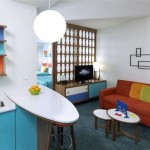Interior Design Programming: Bridging the Gap Between Creativity and Technology
Interior design, traditionally a field driven by aesthetic sensibilities and spatial understanding, has embraced the power of technology in recent years. This convergence has given rise to a new domain: interior design programming. Interior design programming is the process of applying computational tools and techniques to analyze, design, and manage interior spaces. This approach leverages the capabilities of software, algorithms, and data-driven insights to enhance the efficiency, accuracy, and creative possibilities of interior design.
1. Enhanced Functionality and Efficiency
One of the most significant benefits of interior design programming is its ability to improve functionality and efficiency. Software tools can automate tasks such as space planning, furniture layout, and material selection. For instance, 3D modeling software allows designers to create virtual representations of spaces, experiment with different design configurations, and visualize the final outcome before actual construction. This virtual prototyping process significantly reduces the time and cost associated with physical mockups and revisions.
Furthermore, interior design programming facilitates data-driven decision-making. By analyzing data on user behavior, lighting conditions, and environmental factors, designers can create spaces that are not only aesthetically pleasing but also functionally optimized. For example, software can analyze foot traffic patterns in a retail space to determine the optimal placement of merchandise and signage, leading to increased sales and customer satisfaction.
2. Unlocking Creative Potential
While some may perceive programming as a constraint on creativity, it can actually unlock new avenues for artistic expression. Interior design programming empowers designers to experiment with complex geometries, parametric design principles, and generative algorithms. These techniques allow for the creation of intricate and highly personalized spaces that would be difficult or impossible to achieve using traditional methods.
For instance, generative design algorithms can generate multiple design variations based on user-defined parameters, such as budget, materials, and functional requirements. Designers can then choose from these variations, selecting the one that best aligns with their vision and client's needs. This iterative approach fosters a collaborative design process, where technology acts as a tool for exploration and innovation.
3. Sustainable and Data-Driven Design
Sustainability and data-driven design are becoming increasingly important in the interior design industry. Interior design programming can contribute to both these objectives. Software can analyze environmental factors such as solar orientation and natural ventilation to optimize energy efficiency and minimize the environmental impact of design decisions. For example, designers can use software to simulate different lighting scenarios and select energy-efficient lighting fixtures, leading to reduced electricity consumption.
Furthermore, interior design programming allows for the creation of interactive and responsive spaces. Using sensors and data analytics, designers can create dynamic environments that adapt to user behavior and environmental conditions. This could include adjusting lighting levels based on occupancy, controlling temperature settings automatically, or providing personalized lighting and climate control based on user preferences. Such data-driven design approaches create more comfortable, energy-efficient, and user-centric spaces.

What S This About Programming And Site Ysis Qpractice

The Interior Design Process Student

The Interior Design Process Phase 01 Concept Programming

Research Based Programming For Interior Design Lily B Robinson Fairchild Books

Programming Worksheet Interior Design Programs Bubble Diagram Architectural Lettering

Phases Of An Interior Design Project What You Can Expect And When To It Studio Croft

Interior Design Process Alx Interiors

What Does The Interior Design Process Look Like J Hill Interiors

Our Process Purva Design Studio

Pin By Gregezzo On Models Sketches Sections Etc Interior Design Programs Architecture Program Presentation








